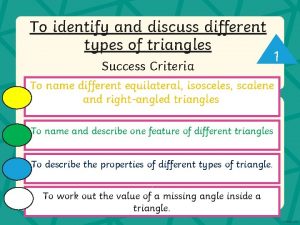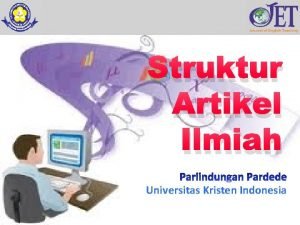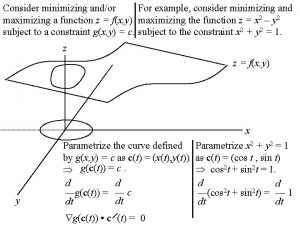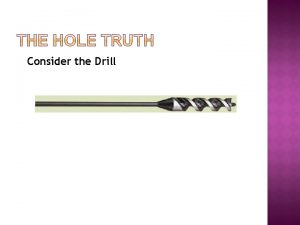Systems Approach AIM To consider a systems approach














- Slides: 14

Systems Approach AIM: To consider a systems approach to designing electronic circuits PRIOR KNOWLEDGE: Input devices, output devices, transducer drivers and process circuits www. pfnicholls. com

Introduction System diagrams show the different parts of a complex electronic system connect and interact. System diagrams are sometimes called block diagrams. The boxes represent electronic sub-systems but do not give details of how the sub-system works. The arrows between the boxes represent the flow of information, not physical wires or other types of connection. The most basic system diagram has an INPUT, a PROCESS and an OUTPUT. . . and that's it. All systems can be expressed in terms of inputs, processes and outputs at the most basic level.

System Diagram A more detailed system diagram includes the names and functions of each sub-system and shows how they are connected together. Details of the circuits used, component values and other technical data is not included in the system diagram. The system diagram shown is for an outside light that comes on when movement is detected at night. The system diagram shows what sub-systems are required but not how they are implemented electronically.

Advantages of a Systems Approach The advantage of using a systems based approach to electronics is that each sub-system can be designed and tested separately which makes finding problems and mistakes much easier. In a large system different sub-systems can be designed and tested by different engineers as it is clear what each sub-system needs to do and how it relates to all the other sub-systems. Another advantage of a systems based approach is that one subsystem can be upgraded or modified as necessary without having to change the whole circuit.

Input Sub-System Input Transducers convert information in the real physical world into electrical signals. Input Transducers can produce either a digital or an analogue signal. Many Input Transducers (LDRs, Thermistors, variable resistors) change their resistance as the environmental conditions change. These input transducers need to be used as part of a potential divider to convert the changing resistance into a changing voltage or current that can be processed.

Examples of Input Transducers Used as part of a potential divider, LDRs convert light level into an analogue voltage. In a potential divider, thermistors convert temperature into an analogue voltage. Variable resistors or potentiometers - produce an analogue voltage that depends on position or angle. Push buttons and switches are used with pull-up or pull-down resistors to produce a digital signal that depends on the user input e. g. Logic 1 when the button is pressed. Microphones produce an analogue signal that relates to sound level. Magnetic field detectors produce an analogue signal that depends on the strength of the magnetic field. Motion sensors such as PIR sensors give a digital output when movement is detected. A pressure pad gives a digital signal when pressure is applied e. g. a Logic 1 when someone stands on the pad. A moisture detector, as part of a potential divider, gives an analogue signal that depends on the moisture (of the soil for example).

Process Sub-System Processes respond to and process electrical signals from the input transducers. The processed electrical signals are then interpreted by the output transducers. Process sub-systems can be analogue (amplifiers etc) or digital (logic circuits, for example). The process sub-systems are constructed from active components meaning they need a power supply to function.

Examples of Processes Combinational Logic operations (AND, OR, NOT etc) Timers (monostables) Oscillators producing pulses (astables) Memory and Latches (bistables, flip flops) Comparators (op-amp circuits) Amplifiers Counters (binary and decade) Analogue to Digital Convertor (ADC) - an Op-Amp circuit Digital to Analogue Convertor (DAC) Micro-controllers (PICs etc)

Transducer Drivers are necessary to increase the voltage, current (and consequently) power of the process sub-systems so that the output transducers can function correctly. Examples of Transducer Drivers include: • MOSFETs • Bipolar Transistors • Electromagnetic relays • Power Amplifiers For example, a logic gate can drive an LED sufficiently well but cannot drive a 24 W bulb. In this case a transducer driver is required to increase the current available for the bulb.

Output Transducers convert electrical signals into actions in the real physical world. Output transducers can require high voltages or a large current to operate and so a transducer driver may be required to connect the process sub-system to the output transducer. Output Transducers can be either digital or analogue.

Examples of Output Transducers Bulbs and LEDs produce light (analogue or digital) Motors produce motion and movement (analogue) Solenoids produce movement (digital). The solenoid is either in one position or the other e. g. a door lock. Actuators or Servos produce motion related to a position (analogue) Loudspeakers and Buzzers produce sound. Loudspeakers are usually connected to an amplifier of some sort (analogue). A buzzer is either on or off (digital) Displays such as LED bar graphs, 7 segment displays or LCD and OLED displays can produce letters and numbers Heaters increase the temperature (analogue or digital)

Summary • A systems approach simplifies the design process • System diagrams represent the flow of information between sub-systems • Input transducers respond to changes in the real world to produce electrical signals • Process sub-systems respond to, combine or change analogue or digital electrical signals from the input transducers • Output transducers use electrical signals to make changes in the real world • Transducer drivers may be necessary between the process sub-system and the output transducers to increase the current, voltage or power available

Questions 1. What is the advantage of a systems approach? 2. What are the sub-systems in the most basic electronic system? 3. What do input transducers do? 4. What do output transducers do? 5. What do process sub-systems do? 6. Why might a transducer driver be necessary?

Answers 1. The problem can be considered without detailed circuit design. Individual sub-systems can be designed separately and tested or upgraded separately 2. Input, process, output 3. Input transducers convert information from the real physical world into electrical signals 4. Output transducers convert electrical signals into changes in the real world 5. Process sub-systems respond to electrical signals from the inputs and produce electrical signals for the outputs 6. Transducer drivers may need to increase the current, voltage or power available to the output transducers
 A switch in a datagram network uses
A switch in a datagram network uses Theoretical models of counseling
Theoretical models of counseling Waterfall and sprinkler strategy
Waterfall and sprinkler strategy Multiple approach-avoidance conflict
Multiple approach-avoidance conflict Bandura's reciprocal determinism
Bandura's reciprocal determinism Study approach meaning
Study approach meaning Traditional approach to system development
Traditional approach to system development Deep learning approach and surface learning approach
Deep learning approach and surface learning approach Peter steiner videos
Peter steiner videos Osu slds aim
Osu slds aim Auto transformer definition
Auto transformer definition Aim triangle
Aim triangle Method of scouting
Method of scouting Aim suffix
Aim suffix Aimradc
Aimradc



























